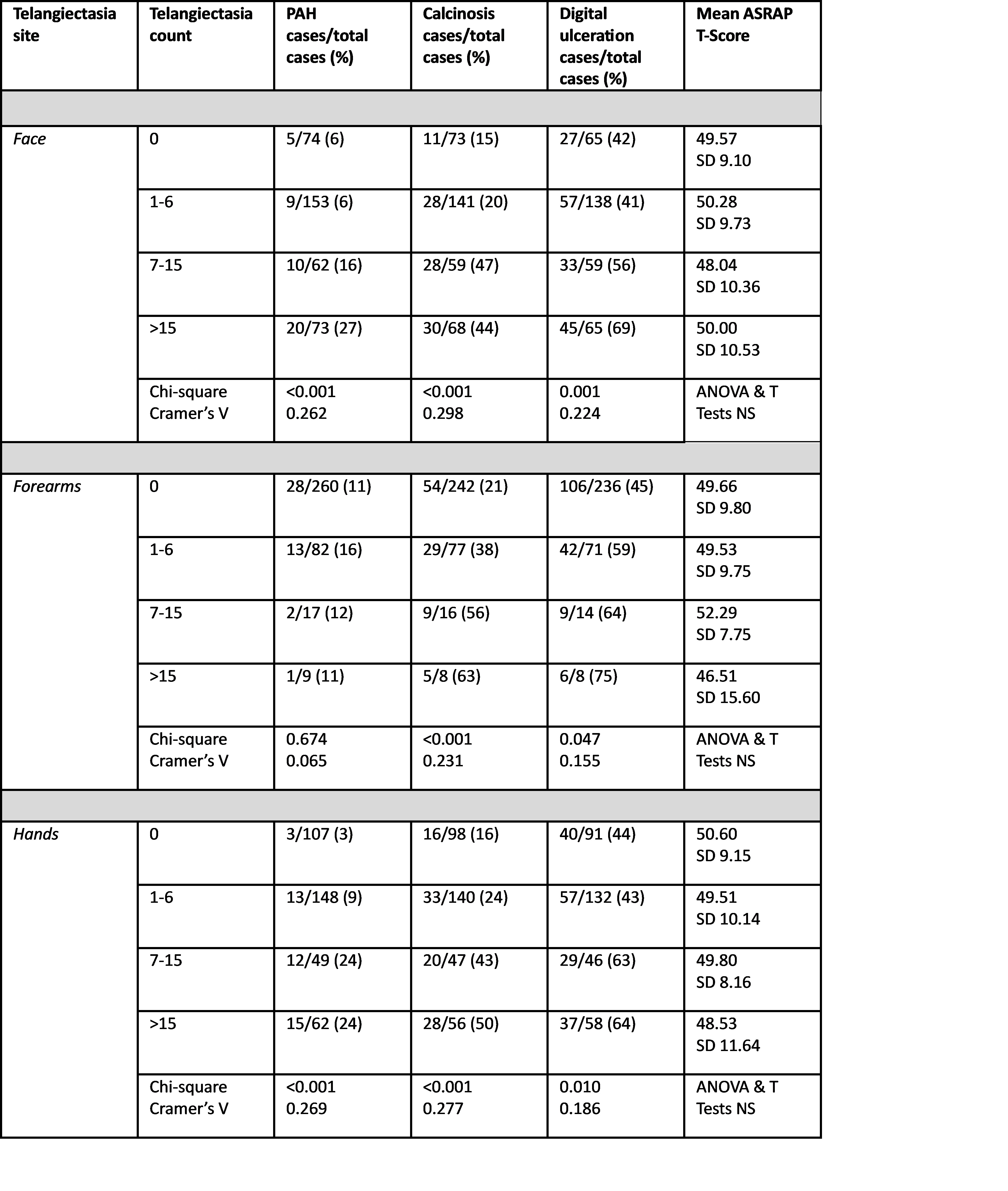Session Information
Session Type: Poster Session B
Session Time: 10:30AM-12:30PM
Background/Purpose: Telangiectasia are permanently dilated dermal postcapillary venules and are the 2nd most common manifestation (~80%) of systemic sclerosis (SSc) after Raynaud’s phenomenon (RP). The potential clinical utility of telangiectasia as a marker of broader vascular involvement in SSc has been somewhat neglected. The present study examined the relationship between major vascular features of SSc and the presence, quantity and distribution of telangiectasia.
Methods: The Assessment of Systemic Sclerosis Associated-Raynaud’s Phenomenon (ASRAP) validation study dataset captured a physician assessment of the quantity of telangiectasia across the face, forearms and hands which were categorised into groups of 0, 1-6, 7-15 and >15 at each anatomical site. Case records were examined for clinical phenotype including a history of right-heart catheter confirmed pulmonary artery hypertension (PAH), a history of calcinosis and history of digital ulceration (DU). The severity of RP was assessed using ASRAP. Pearson’s Chi-square, T-tests and ANOVA were used for between group comparisons as required. The effect size was estimated using Cramer’s V (< 0.2 weak; 0.2-≤0.6 moderate and >0.6 strong effect size).
Results: The ASRAP dataset consisted of 404 SSc patients (mean age 58.9, SD 12.4; 79.7% female) fulfilling the 2013 ACR/EULAR classification criteria for SSc (39.6% anti-centromere, 17.3% anti-Scl70 and 17.3% anti-RNA pol III). Telangiectasia are common in SSc affecting >75% of subjects in this convenience sample. A higher quantity of telangiectasia in both the face and hands was associated with a significantly higher proportion of patients with PAH, calcinosis and DU (Figure and Table). The strength of the relationship was weakest for quantity of telangiectasia in the hands and history of DU (Cramer’s V 0.186), despite their anatomical proximity. In contrast, only calcinosis and DU were more prevalent amongst patients with a higher quantity of telangiectasia in the forearms (Table), and the proportion of patients with telangiectasia at the forearm was notably lower than for face and hands. RP severity was not associated with the presence or quantity of telangiectasia at any anatomical site either in the entire cohort or in anti-centromere antibody positive only cases.
Conclusion: The presence, distribution and quantity of telangiectasia are associated with other distinct vascular manifestations of SSc such as PAH, DU and calcinosis, but not RP severity. The relationship between telangiectasia count and vascular manifestations appears to differ according to their anatomical site. These findings highlight the inter-relationship between vascular manifestations of SSc and may have clinical utility for stratification of vascular risk in SSc.
ASRAP, Assessment of systemic sclerosis associated-Raynaud’s phenomenon; NS, Non-significant; PAH, pulmonary artery hypertension; SD, standard deviation
To cite this abstract in AMA style:
Wells M, Domsic R, Shah A, Hummers L, Anilkumar A, Frech T, Herrick A, Denton C, Khanna D, Pauling J. The Relationship Between the Presence, Quantity and Distribution of Cutaneous Telangiectasia and Other Vascular Manifestations of Systemic Sclerosis [abstract]. Arthritis Rheumatol. 2024; 76 (suppl 9). https://acrabstracts.org/abstract/the-relationship-between-the-presence-quantity-and-distribution-of-cutaneous-telangiectasia-and-other-vascular-manifestations-of-systemic-sclerosis/. Accessed .« Back to ACR Convergence 2024
ACR Meeting Abstracts - https://acrabstracts.org/abstract/the-relationship-between-the-presence-quantity-and-distribution-of-cutaneous-telangiectasia-and-other-vascular-manifestations-of-systemic-sclerosis/


